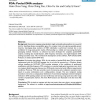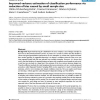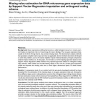BMCBI
2006
13 years 11 months ago
2006
Background: A large number of genes usually show differential expressions in a microarray experiment with two types of tissues, and the p-values of a proper statistical test are o...
BMCBI
2006
13 years 11 months ago
2006
Background: Association mapping using abundant single nucleotide polymorphisms is a powerful tool for identifying disease susceptibility genes for complex traits and exploring pos...
BMCBI
2006
13 years 11 months ago
2006
Background: Microarray data analysis is notorious for involving a huge number of genes compared to a relatively small number of samples. Gene selection is to detect the most signi...
BMCBI
2006
13 years 11 months ago
2006
Background: In bio-systems, genes, proteins and compounds are related to each other, thus forming complex networks. Although each organism has its individual network, some organis...
BMCBI
2006
13 years 11 months ago
2006
BMCBI
2006
13 years 11 months ago
2006
Background: Phylogenetic analysis is emerging as one of the most informative computational methods for the annotation of genes and identification of evolutionary modules of functi...
BMCBI
2006
13 years 11 months ago
2006
Background: Statistical methods for identifying positively selected sites in protein coding regions are one of the most commonly used tools in evolutionary bioinformatics. However...
BMCBI
2006
13 years 11 months ago
2006
Background: Supervised learning for classification of cancer employs a set of design examples to learn how to discriminate between tumors. In practice it is crucial to confirm tha...
BMCBI
2006
13 years 11 months ago
2006
Background: Retinal photoreceptors are highly specialised cells, which detect light and are central to mammalian vision. Many retinal diseases occur as a result of inherited dysfu...
BMCBI
2006
13 years 11 months ago
2006
Background: Gene expression profiling has become a useful biological resource in recent years, and it plays an important role in a broad range of areas in biology. The raw gene ex...



